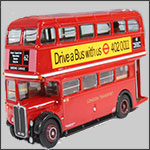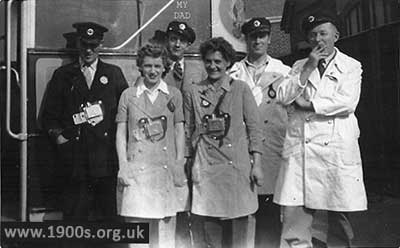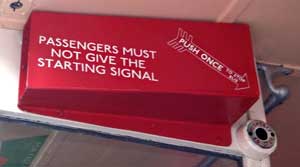Bus drivers on London Transport buses, mid-20th century

This page is about the role and work of bus drivers on London Transport buses in the mid-20th Century
____
By the webmaster, based childhood observations, discussions with people who lived with these buses and additional research
When I was growing up in 1940s and 1950s London, every bus had a driver and a conductor.
The driver was set apart in his own front cubicle, separated from everyone else by a glass window. Unlike the conductor he never spoke to passengers and, also unlike the conductor, his work was entirely sedentary.
Most of my memories are of the drivers being older men as during the Second World War as the young and fit men were away in the forces. Even after the war, I don't remember any women bus drivers, but if you do, please let me know.
Bus drivers' uniforms

The bus drivers are in the back row wearing the white coats. Photo courtesy of Norman Partridge
Bus drivers' Summer uniform and problems of washing it
contributed by Norman Partridge whose father drove the Routemaster buses
My father, Walter Albert Partridge, was a bus driver working at the Forest Gate Depot in the late 1940s. The photo shows him with some of his mates, wearing his summer coat. Although it looks grey in the shadow of the photo, it was always a brilliant white which my mother was seriously proud of. He had two such coats which she made him change twice a week because the right sleeve tended to get grubby from him having to put his arm out of the window to do hand signalling. There were no indicators on the buses in those old days.
Bus drivers usually worked with the same conductors. My father's conductor was the guy in the black coat in the photo, but when it was his rest day, the woman next to him would take his place. All three are wearing the ticket machines which punched holes in passengers' tickets to show the fare stage where they had paid to get off.
Stopping and starting a bus
The skill of the drivers
contributed by Staff at Brooklands Bus Museum
It is tricky for a driver of today to drive these old buses because every gear change required double de-clutching. It is a tribute to their skill of these old bus drivers that the passengers' rides were so smooth.
Bus drivers knew their routes well.
They stopped at bus stops and would start the bus again when they heard the conductor give a double ding on the bell.
Push button inside a bus requesting the bus driver to stop at a request stop. Photographed at Brooklands Bus Museum
Driving the 'new' Routemaster buses
Although I understand that the famous Routemaster buses were developed in the 1950s, they did not come to Edgware, where I lived until the early 1960s.
I had assumed that the transmission was automatic, which had not been properly tuned because the journeys were punctuated with serious jolts as the engines changed gear. We passengers were repeatedly thrown violently all over the place. It couldn't be allowed to continue and fortunately it didn't for long.
According to Norman Partridge and Douglas Adam, the transmission was not completely automatic - see the boxes below.
Gear transmission on Routemaster buses
contributed by Norman Partridge
I'm fairly sure that the Routemasters had what is known as 'Pre-select transmission', and I recall my Dad saying that Pre-Select was a B****r to get used to.
contributed by Douglas Adam
With the pre-selector gearbox, nothing happens when the gearshift lever is actuated until the clutch is depressed. Only then is the gear automatically changed. If the engine speed (the gear) is outside the normal range for the vehicle's speed, a serious mis-match results in a forward or backward lurch.
| sources | webmaster | contact |
Text and images are copyright
If you can add anything to this page or provide a photo, please contact me.




